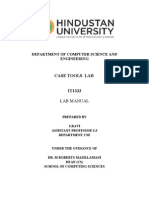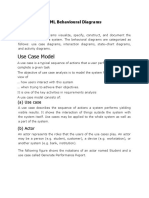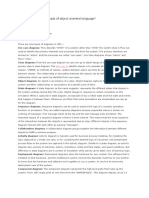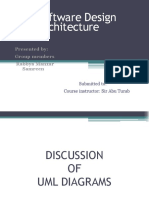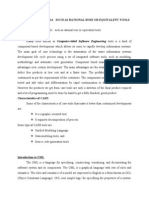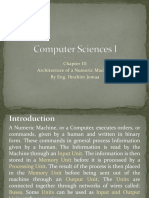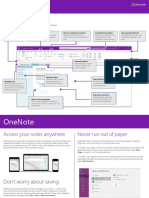Object-Oriented Software Engineering
Practical Software Development using UML and Java
Chapter 8:
Modelling Interactions and Behaviour
Lecture 11
8.1 Interaction Diagrams
Interaction diagrams are used to model the dynamic aspects
of a software system
• They help you to visualize how the system runs.
• An interaction diagram is often built from a use case and a
class diagram.
—The objective is to show how a set of objects accomplish
the required interactions with an actor.
546
�Interactions and messages
• Interaction diagrams show how a set of actors and objects
communicate with each other to perform:
—The steps of a use case, or
—The steps of some other piece of functionality.
• The set of steps, taken together, is called an interaction.
• Interaction diagrams can show several different types of
communication.
—E.g. method calls, messages send over the network
—These are all referred to as messages.
547
Elements found in interaction diagrams
• Instances of classes
—Shown as boxes with the class and object identifier
underlined
• Actors
—Use the stick-person symbol as in use case diagrams
• Messages
—Shown as arrows from actor to object, or from object to
object
548
�Creating interaction diagrams
You should develop a class diagram and a use case model
before starting to create an interaction diagram.
• There are two kinds of interaction diagrams:
—Sequence diagrams
—Communication diagrams
549
Sequence diagrams – an example
550
�Sequence diagrams
A sequence diagram shows the sequence of messages exchanged by the set
of objects performing a certain task
• The objects are arranged horizontally across the diagram.
• An actor that initiates the interaction is often shown on the left.
• The vertical dimension represents time.
• A vertical line, called a lifeline, is attached to each object or actor.
• The lifeline becomes a broad box, called an activation box during the live
activation period.
• A message is represented as an arrow between activation boxes of the
sender and receiver.
—A message is labelled and can have an argument list and a return
value.
551
Sequence diagrams –
same example, more details
552
�Sequence diagrams –
an example with replicated messages
• An iteration over objects is indicated by an asterisk preceding the
message name
553
Sequence diagrams –
an example with object deletion
• If an object’s life ends, this is shown with an X at the end of the lifeline
554
�Communication diagrams – an example
555
Communication diagrams
Communication diagrams emphasize how the objects
collaborate in order to realize an interaction
• A communication diagram is a graph with the objects as the
vertices.
• Communication links are added between objects
• Messages are attached to these links.
—Shown as arrows labelled with the message name
• Time ordering is indicated by prefixing the message with
some numbering scheme.
556
�Communication diagrams –
same example, more details
557
Communication links
• A communication link can exist between two objects
whenever it is possible for one object to send a message to the
other one.
• Several situations can make this message exchange possible:
1. The classes of the two objects have an association
between them.
- This is the most common case.
- If all messages are sent in the same direction, then probably the
association can be made unidirectional.
558
�Other communication links
2. The receiving object is stored in a local variable of
the sending method.
- This often happens when the object is created in the sending
method or when some computation returns an object .
- The stereotype to be used is «local» or [L].
3. A reference to the receiving object has been received
as a parameter of the sending method.
- The stereotype is «parameter» or [P].
559
Other communication links
4. The receiving object is global.
- This is the case when a reference to an object can be obtained
using a static method.
- The stereotype «global», or a [G] symbol is used in this case.
5. The objects communicate over a network.
- We suggest to write «network».
560
�How to choose between using a sequence
or communication diagram
Sequence diagrams
• Make explicit the time ordering of the interaction.
—Use cases make time ordering explicit too
—So sequence diagrams are a natural choice when you build
an interaction model from a use case.
• Make it easy to add details to messages.
—Communication diagrams have less space for this
561
How to choose between using a sequence
or communication diagram
Communication diagrams
• Can be seen as a projection of the class diagram
—Might be preferred when you are deriving an interaction
diagram from a class diagram.
—Are also useful for validating class diagrams.
562
�Communication diagrams and patterns
A communication diagram can be used to represent aspects of a design
pattern
563
8.2 State Diagrams
A state diagram describes the behaviour of a system, some
part of a system, or an individual object.
• At any given point in time, the system or object is in a certain
state.
—Being in a state means that it will behave in a specific way
in response to any events that occur.
• Some events will cause the system to change state.
—In the new state, the system will behave in a different way
to events.
• A state diagram is a directed graph where the nodes are states
and the arcs are transitions.
564
�State diagrams – an example
• tic-tac-toe game (also called noughts and crosses)
565
States
• At any given point in time, the system is in one state.
• It will remain in this state until an event occurs that causes it
to change state.
• A state is represented by a rounded rectangle containing the
name of the state.
• Special states:
—A black circle represents the start state
—A circle with a ring around it represents an end state
566
�Transitions
• A transition represents a change of state in response to an
event.
—It is considered to occur instantaneously.
• The label on each transition is the event that causes the change
of state.
567
State diagrams – an example of transitions
with time-outs and conditions
568
�State diagrams – an example with
conditional transitions
569
Activities in state diagrams
• An activity is something that takes place while the system is in
a state.
—It takes a period of time.
—The system may take a transition out of the state in
response to completion of the activity,
—Some other outgoing transition may result in:
- The interruption of the activity, and
- An early exit from the state.
570
�State diagram – an example with activity
571
Actions in state diagrams
• An action is something that takes place effectively
instantaneously
—When a particular transition is taken,
—Upon entry into a particular state, or
—Upon exit from a particular state
• An action should consume no noticeable amount of time
572
�State diagram – an example with actions
573
State diagrams – another example
574
�Nested substates and guard conditions
A state diagram can be nested inside a state.
• The states of the inner diagram are called substates.
575
State diagram – an example with substates
576
�8.3 Activity Diagrams
• An activity diagram is like a state diagram.
—Except most transitions are caused by internal events, such as the
completion of a computation.
• An activity diagram
—Can be used to understand the flow of work that an object or
component performs.
—Can also be used to visualize the interrelation and interaction between
different use cases.
—Is most often associated with several classes.
• One of the strengths of activity diagrams is the representation of
concurrent activities.
577
Activity diagrams – an example
578
�Representing concurrency
• Concurrency is shown using forks, joins and rendezvous.
—A fork has one incoming transition and multiple outgoing
transitions.
- The execution splits into two concurrent threads.
—A rendezvous has multiple incoming and multiple
outgoing transitions.
- Once all the incoming transitions occur all the outgoing
transitions may occur.
579
Representing concurrency
—A join has multiple incoming transitions and one outgoing
transition.
- The outgoing transition will be taken when all incoming
transitions have occurred.
- The incoming transitions must be triggered in separate threads.
- If one incoming transition occurs, a wait condition occurs at the
join until the other transitions occur.
580
�Swimlanes
Activity diagrams are most often associated with several
classes.
• The partition of activities among the existing classes can be
explicitly shown using swimlanes.
581
Activity diagrams – an example with
swimlanes
582
�8.4 Implementing Classes Based on
Interaction and State Diagrams
• You should use these diagrams for the parts of your system
that you find most complex.
—I.e. not for every class
• Interaction, activity and state diagrams help you create a
correct implementation.
• This is particularly true when behaviour is distributed across
several use cases.
—E.g. a state diagram is useful when different conditions
cause instances to respond differently to the same event.
583
�Example: The CourseSection class
States:
• ‘Planned’:
closedOrCancelled == false && open == false
• ‘Cancelled’:
closedOrCancelled == true &&
registrationList.size() == 0
• ‘Closed’ (course section is too full, or being taught):
closedOrCancelled == true &&
! registrationList.size() > 0
585
Example: The CourseSection class
States:
• ‘Open’ (accepting registrations):
open == true
• ‘NotEnoughStudents’ (substate of ‘Open’):
open == true &&
! ! registrationList.size() < course.getMinimum()
• ‘EnoughStudents’ (substate of ‘Open’):
open == true &&
! ! registrationList.size() >= course.getMinimum()
586
�Example: The CourseSection class
public class CourseSection
{
// The many-1 abstraction-occurrence association (Figure 8.2)
private Course course;
// The 1-many association to class Registration (Figure 8.2)
private List<Registration> registrationList;
// The following are present only to determine the state
// (as in Figure 8.19). The initial state is 'Planned‘
private boolean open = false;
private boolean closedOrCanceled = false;
587
Example: The CourseSection class
public CourseSection(Course course)
{
this.course = course;
registrationList = new LinkedList<Registration>();
}
public void openRegistration()
{
if(!closedOrCanceled) // must be in 'Planned' state
{
open = true; // to 'OpenNotEnoughStudents' state
}
}
"
"
588
�Example: The CourseSection class
public void closeRegistration()
{
// to 'Canceled' or 'Closed' state
open = false;
closedOrCanceled = true;
if (registrationList.size() < course.getMinimum())
{
unregisterStudents(); // to 'Canceled' state
}
}
public void cancel()
{
// to 'Canceled' state
open = false;
closedOrCanceled = true;
unregisterStudents();
}
589
Example: The CourseSection class
public void requestToRegister(Student student)
{
if (open) // must be in one of the two 'Open' states
{
// The interaction specified in the sequence diagram of Figure 8.4
Course prereq = course.getPrerequisite();
if (student.hasPassedCourse(prereq))
{
// Indirectly calls addToRegistrationList
new Registration(this, student);
}
// Check for automatic transition to 'Closed' state
if (registrationList.size() >= course.getMaximum())
{
// to 'Closed' state
open = false;
closedOrCanceled = true;
}
}
}
"
590
�Example: The CourseSection class
// Private method to remove all registrations
// Activity associated with 'Canceled' state.
private void unregisterStudents()
{
for(Registration next : registrationList)
{
next.unregisterStudent();
registrationList.remove(next);
}
}
// Called within this package only, by the constructor of
// Registration to ensure the link is bi-directional
void addToRegistrationList(Registration newRegistration)
{
registrationList.add(newRegistration);
}
}
591
8.5 Difficulties and Risks in Modelling
Interactions and Behaviour
Dynamic modelling is a difficult skill
• In a large system there are a very large number of possible paths a system
can take.
• It is hard to choose the classes to which to allocate each behaviour:
—Ensure that skilled developers lead the process, and ensure that all
aspects of your models are properly reviewed.
—Work iteratively:
- Develop initial class diagrams, use cases, responsibilities, interaction
diagrams and state diagrams;
- Then go back and verify that all of these are consistent, modifying them as
necessary.
—Drawing different diagrams that capture related, but distinct,
information will often highlight problems.
592





